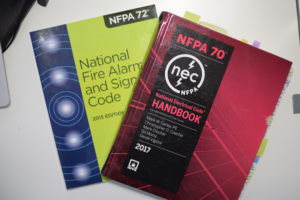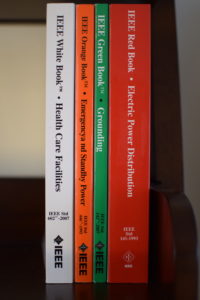Laws, Ordinances, Building codes, Standards & Best Engineering Practices, what is the difference? When should we use one or the other? Are we required to comply with some or with all of them? These are normal questions that every Electrical Engineer has from time to time. It is a confusing subject. We tend to memorize when to apply one or the other based on our past experiences, and we forget how we arrived at those conclusions.
When I first started as a designer, I remember making design mistakes because I didn’t incorporate the requirements of all the codes that were applicable to those designs. The reason was not laziness, but pure ignorance. I just didn’t know I was required to comply with any other code besides the National Electrical Code (NEC). I also remember that my PE at the time was kind enough to let me know about such mistakes, usually late on Fridays, which meant that I had to stay late and work on the weekend to correct the designs and meet the deadline. I learned very quickly about those other codes after that.
Sadly, my experience is very common. Most colleges and universities do not include any classes about building codes in their electrical engineering curriculum. This forces new designers to “learn by doing” and puts a great burden on the employers to train those inexperienced designers. Hopefully, this will shed some light on the subject.
Laws and Building Codes
Compliance with the Law should be very clear. We all need to comply with the federal and state laws at all times. Ignorance does not excuse noncompliance with the law. If you have questions about which laws apply to you, please consult with an attorney (I’m an electrical engineer after all).
Building Codes focus on the construction world. Every State has their own building code adopted via a state law, by requirement of the building department, the professional licensing board or both.
The building code in Massachusetts is the 780 CMR which the state adopted via the Massachusetts General Law, Chapter 143, Sections 93 – 1001. Compliance with 780CMR is required in MA as is mandated by the state law.
At the time of writing this article, the building code in effect in Massachusetts is the 780CMR 9th edition. It adopts the 2015 International Building Code (IBC) with local amendments and revisions. This means that we must use the 2015 IBC and, when we find an article that is applicable to our design, apply the amendments and revisions indicated in 780 CMR.
Ordinances
Ordinances are laws that are applicable to a particular town or city. Compliance with them are mandatory and they are enforced by the local police department.
In some cases, Ordinances have requirements that affect the electrical design. Some notable examples include lighting and noise pollution, where the Ordinance mandates not to exceed a certain number of foot-candles or dBA at the property line. These requirements would affect the site lighting design and, possibly, the kind of enclosure that should be specified for a generator, if applicable.
NEC and other codes

In general, we are required to comply only with the codes adopted by the State or institution where the project is located. These additional codes are usually adopted by the State building code. If a certain code has not been adopted by that state, then we don’t need to comply with it.
I will illustrate this point with the NFPA101, better known as the “Life Safety Code”. While several States have adopted this code, it is not referenced in 780 CMR. Therefore, for designs in MA, we are not mandated to comply with NFPA 101, unless specifically required by other agencies (ie: Department of Public Health). The fact that compliance is not mandated does not prevent us from complying if our design and/or client requires it.
Another good example is the electrical code. For designs in Massachusetts we must comply with the 2020 NEC and, when we find an article that is applicable to our design, apply the amendments and revisions indicated in 527 CMR 12.00. The road there is not that simple, and it requires a breakdown analysis of all of the building codes in effect.
According to the 2015 IBC, all electrical designs must comply with NFPA702 (A.K.A NEC). However, 780 CMR amended and revised this article to require compliance, not with NEC, but with 527 CMR 12.003 which is the “Massachusetts Electrical Code” at the time of writing this article. The Massachusetts Electrical Code in turn adopted the 2020 National Electrical Code (NFPA70)4 with local amendments and revisions.
Standards
Standards are publications aimed to improve the engineering design above what the codes require. They are written by institutions like the “National Fire Protection Association” (NFPA) and the “Institute of Electrical and Electronics Engineers” (IEEE), and their compliance is optional unless they have been made mandatory by the local building code.

One notable example is the “Standard for Electrical Safety in the Workplace” (NFPA70E). This publication has several articles that could affect the electrical design. Its intent is to reduce the risk of injury to the electrical operators by trying to reduce their exposure to live parts, and by reducing the available short circuit and arc flash.
The MA building code has not yet adopted NFPA70E therefore compliance with its requirements is not mandatory. However, as licensed professionals we have the duty of ensuring the public’s safety, and therefore it is strongly advisable to consider implementing NFPA70E in whole or in part. Bear in mind that this usually results in a more expensive installation as it would require adjustable breakers and probably bigger switchboards. For this reason, we should always discuss these considerations with the project’s investors and owners while providing them with as much information as possible regarding the advantages of NFPA70E and possible consequences of non-compliance, so that they can make an informed decision. When compliance with particular standard is not mandatory, the decision on whether or not to use it rests solely with the project’s investors and owners.
On the flip side, there are cases where some standards are mandatory since they were adopted by another code. A good example of this is the “Standard for Emergency and Standby Power System” (NFPA110) which was adopted by 2015 IBC5 and such adoption was not amended by 780 CMR. Therefore, all generator installations in MA must comply with NFPA 110.
Good Engineering Practices
These are usually unofficial “recipes” developed by the designers based on their past experiences. For example, specifying panelboards with a hinged doors and a hinged covers (A.K.A. Door-in-door) is not required by any code or standards but proves to be extremely helpful to an electrician performing future upgrades in that panelboard. Their cost is marginal when buying new panelboards.
Another recipe example is the decision not to use panelboards with Main Circuit Breakers (MCB). Instead, the electrical engineer may choose to use an enclosed circuit breaker to serve a Main Lugs Only (MLO) panelboard. Electrically speaking these two approaches are identical. However, in practice, the MCB panelboard will have a higher risk of electrical shock to the electrical operator since the “line” side of the MCB will always be energized unless the upstream breaker is opened.
This risk can be eliminated in the MLO equivalent by opening the enclosed circuit breaker. The MLO solution is, however, usually more expensive and will require more wall space to install. Therefore, we should evaluate if the budget and the available building space could accommodate this solution before its implementation.
In conclusion, the designs must always comply with the Laws, Ordinances and Building codes. Compliance with standards & best engineering practices is optional but recommended.
If you have questions about this subject, feel free to contact me at [email protected] or visit our website at https://levelupec.com
References
- 780CMR 9th edition, Chapter 1, Section 101, Article 101.2
- 2015 IBC, Chapter 27, Section 2701, Article 2701.1
- 780CMR 9th edition, Chapter 27, Section 2701, Article 2701.1
- 527 CMR 12.00
- 2015 IBC, Chapter 27, Section 2702, Article 2702.1.2

